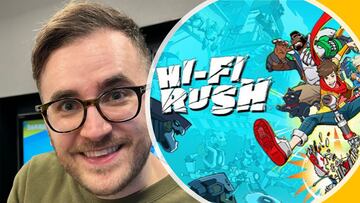Interview
Hi-Fi Rush: "We built the levels based on theoretically what the song would be like”
We spoke with John Johanas, the director behind this fantastic Bethesda development.

We had the opportunity to speak with John Johanas, the director of Hi-Fi Rush, the incredible title that has surprised everyone with its release and created a lot of buzz in the gaming community.
Hi-Fi Rush shows a combination of gameplay that usually goes separately. What was the process to have that mix of rhythm and action?
JJ. So the idea of combining those aspects was mainly because I just hadn't seen it done in a way that I liked and I thought that in theory they go well together, like action and synchronizing to the rhythm just works very well. It's kind of like a high-tension, you know, pleasurable experience. And I was always kind of waiting for somebody to make a game like that. So when I had the chance to make something like this, I took it and tried to put it together, even though it was a difficult concept, to begin with. I really wanted to do it because I think that if I wanted to do it, there are probably other people out there who would enjoy that experience as well.
Players have already discovered that near the end of the game, there is a reference to the studio confirming the return of a horror game. Should fans of The Evil Within take this seriously?
Yeah, that should be taken on the same level as any other scrolling text that you see in the game. There's a lot of just comedic stuff in the game. I wouldn't look too deep into it.
Who is JoJo's Bizarre Adventure fan who put references in the game?
JJ. Oh, well, it is strange that the character of Zanzo was written that way. I wrote him as sort of an anime character brought to life and I just had the idea that he would do this kind of extravagant poses like in Jo Jo's Bizarre Adventure or Fist of the North Star and things like that. And I think when we were working on it. The animators were all big fans of that. I didn't even know where the actual poses came from or at least the references to the actual poses. But yeah, I think that was it. I would say the animators did most of the heavy lifting on those sequences.
How did you make the playlist - did the team do it from the gameplay or did you select the songs first and then work on the gameplay?
JJ. So in terms of choosing the music, the licensed songs, I chose this playlist that originally had a lot of other songs that just kind of had the feeling that we were going through for the game and then we looked at those songs and figured out which ones would work in the game because they had to have a certain, you know, speed and everything like that.
And so we took those and designed the levels around those songs, but we made any track that wasn't licensed in-house. We built the levels based on theoretically what the song would be like if it had an intro, a verse, a chorus, or a bridge section. So that's how we design the levels based on the music.
How does the change in formula feel compared to the games you've worked on?
JJ. Well, as a creator you don't want to just keep doing the same thing over and over again, and I don't have a problem with staying within the same genre as long as you have a good idea of what you want to do. But after we finished The Evil Within 2, I just felt like it was a good time to try something new and kind of refresh ourselves as creators and take on a new challenge. It's very, very difficult because you have to rethink and relearn everything you do. I think it helped us a lot in making the game. I like the talent of the team in terms of thinking about how to approach and solve situations, as well as getting a lot more information about the gameplay aspects of things that we wouldn't have experienced if we weren't playing. So I look at it mostly as a positive, even though it was a very tough journey to get to the end. Overall, I think we came out stronger as developers.
When you developed Hi-Fi Rush, did you think about the Steam Deck?
JJ. I remember the Steam Deck was announced much, much later.When we were pretty much at the end of development and we didn't get our hands on it until the very end. But we liked the way it just played. It looked good on the screen, the portability, and everything like that. We just felt like it was a good platform or a good form fit for the game that we're making as well, so. We just looked to see how we could optimize it for the Steam Deck, but fortunately, we did a lot of heavy optimization in general, so it wasn't that challenging to get it to run on that, but I think it's a great way to play the game.


